Simon Guerrier's Blog, page 47
January 12, 2020
The Star Outside my Window, by Onjali Q Raúf
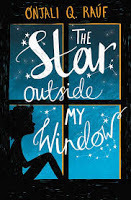 Ten year-old Aniyah is a star hunter, an astronomer, thrilled by the discovery of a new star in the night sky. But she thinks the star is her mum, whose heart has ascended, and is determined to ensure that the star hunters at the Royal Observatory Greenwich give it her mum's name. As she sets off with her friends from the foster home on an epic quest to Greenwich, we realise what Aniyah and her five year-old brother do not: their mum was murdered - by their dad.
Ten year-old Aniyah is a star hunter, an astronomer, thrilled by the discovery of a new star in the night sky. But she thinks the star is her mum, whose heart has ascended, and is determined to ensure that the star hunters at the Royal Observatory Greenwich give it her mum's name. As she sets off with her friends from the foster home on an epic quest to Greenwich, we realise what Aniyah and her five year-old brother do not: their mum was murdered - by their dad.I rattled through this exciting, emotional story full of high stakes. It would be wretched to quibble the practicalities of the journey Aniyah and her friends undertake - is there really a bus from Victoria coach station to Island Gardens, and could you get all that way without anyone checking you'd paid? - or the physics of the star that passes close to Earth. It's certainly never easy, and Aniyah and her friends show incredible daring along the way. The conclusion, in which Aniyah must face the awful truth that she's evaded so long, is beautifully done.
For all the awfulness, the book is peppered with kindly adults - the amazing foster mum Mrs Iwuchukwu who has tragedies in her own life, kindly superhero actress Audrey Something, and helpful astronomer Professor Grewal. The other foster children all have their histories, too - and in the case of all but one of them, that makes them keen to support Aniyah whatever it takes. That really got me: people inspired by their own experience of crisis to help someone else through theirs.
I also liked the resolution for the "villainous" character, Sophie - explaining her insecurities and returning the thing she takes from Aniyah without her ever quite apologising. It's a remarkable adventure but Raúf ensures that it feels credible to the end. The story wraps up the plot about the star satisfactorily but I find myself wondering what becomes of all these characters afterwards - always a good sign in a book.
Raúf explains in the end section the inspiration for the story - the murder of her own aunt Mumtahina, which also inspired her to set up Making Herstory - and is careful about warning readers in advance of the subject matter.
"The author of this story does not like to link the word 'Domestic' to the word 'Abuse'. This is because the word 'Domestic' implies that abuses happening inside the home should remain private, even when they constitute a crime, whilst also making many people too embarrassed to report abuses. However, as the prevailing term, she has used it throughout this book for clarity." (footnote to the dedication)So this is a lively story about a very difficult subject told with flair, insight and sensitivity.
Published on January 12, 2020 04:19
December 30, 2019
The Martian Chronicles, by Ray Bradbury
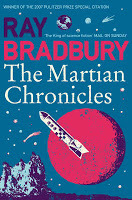 This wasn't what I expected. As a classic of science-fiction, I thought it would be engineer-heroes conquering the frontier and debating the physics of travelators. But The Martian Chronicles (first published in 1950) is altogether stranger, more whimsical and - by the end - unsettling.
This wasn't what I expected. As a classic of science-fiction, I thought it would be engineer-heroes conquering the frontier and debating the physics of travelators. But The Martian Chronicles (first published in 1950) is altogether stranger, more whimsical and - by the end - unsettling.Each chapter is dated and the book covers events between January 1999 and October 2026, as humans attempt to settle on Mars. Some chapters are very short - some merely a couple of pages, one a few paragraphs. But others are long, self-sustained stories so that this feels like a classic "fix-up" novel comprising previously published short stories now loosely connected - as it turns out it is. At first, I thought the depictions of Martians in one story contradicted those in another. And it all seemed achingly okay.
Then I got to "Way Up in the Middle of the Air", first published in the magazine Other Worlds in July 1950 and set in June 2003. As colonisation of Mars hits its stride, in an unnamed part of the southern United States, the whole of the African-American populace decides to emigrate - to the horror of the white people they serve.
"His wife's small sob stopped him. She dabbed at her eyes. 'I kept telling her, "Lucinda," I said, "you stay on and I raise your pay and you get two nights off a week, if you want," but she just looked set! I never seen her so set, and I said, "Don't you love me, Lucinda?" and she said yes, but she had to go because that's the way it was, is all. She cleaned the house and dusted it and put luncheon on the table and then she went to the parlour door and - and stood there with two bundles, one by each foot, and shook my hand and said, "Good-bye, Mrs Teece." And she went out the door. And there was her luncheon on the table, and all of us too upset to even eat it. It's still there now, I know: last time I looked it was getting cold.'There's so much to unpack there! The mix of emotions, that craving for love (and gratitude) by the masters for years of drudging service with only one night off. The threat of violence - not only to the servants but to Teece's wife, who calls her husband "Pa". The vision of life, 53 years in the future from the time the story was written, with no apparent progress in civil rights. I'm surprised to learn this chapter is left out of some later editions as it's the one that really hit me. It's an uncomfortable, troubling story, and I'm still puzzling out exactly why.
Teece almost struck her. 'God damn it, Mrs Teece. You get the hell home. Standin' there makin' a sight of yourself!'" (p. 182)
The second story that really resonated is "The Martian", set in September 2005 and originally published in Super Science Stories in 1949. An elderly couple have moved to Mars after the death of their young son on Earth - but now he comes back to them. When the family go into town on a shopping trip, the son becomes a young girl - the missing daughter of another grieving family. The elderly couple help steal "their" son back, but the son - really a Martian - can't help morphing into the desires of each member of the pursuing crowd. It's horrible, not least because it's clear the humans know that the Martian isn't really what it seems but are overcome with longing. Even at the end, with the Martian gone, the grieving father still waits on the doorstep - the implication being that he waits for the return of a yet another Martian as his son.
In the last third of the book, we start to re-meet characters from previous stories and pick up on threads and whole lives. These people gaze into The Martian night sky at the green (not, as we'd now think, blue) spec of Earth with mixed feelings. On page 224 we're told that many colonists are considering going "home" to Earth, where's there's an impending war.
That's undercut in the very next story, like the former set in November 2005, when one character comments,
"I don't trust those Earth people,' (p. 227).They are no longer Earth people but Earth remains their home, in a contradiction that feels nuanced and convincing. There's then a terrible cataclysm, which we get from the perspective of an ordinary guy worried about the effect it will have on the tourist business in "The Off Season" - a delicious bit of sardonic irony.
I didn't like "The Silent Towns," about a man of no apparent great attraction longing for a woman - and then meeting one he doesn't like. It's a careful-what-you-wish-for tale and the bleak Martian setting made it reminiscent of The Twilight Zone in tone, but there's little more to it than a misogynist twist.
"There Will Come Soft Rains" is very much better, the story of an automated house going through its daily routine in caring for its long-departed human family. Much of it is simply listing small, domestic details, but each one adds to the sense of what has been lost.
And that's true of the book as a whole: whimsical stories that add up to something a whole, an epic of failure and loss. I can see why The Martian Chronicles haunts what has followed in SF, why it's referenced in the Lady Astronaut novels and so on. Its influence is surely felt from the "New New York" (p. 265) that echoes in Russell T Davies' Doctor Who, to Kim Stanley Robinson's Mars trilogy which I now want to revisit after (blimey) at least 20 years.
Published on December 30, 2019 09:00
December 27, 2019
DWM 2020 Yearbook
 Doctor Who Magazine
Doctor Who Magazine2020 YearbookDoctor Who Magazine's 2020 Yearbook is now out, with exclusive access to the cast and crew of the new series plus Nick Setchfield's moving tribute to writer Terrance Dicks, speaking to Terrance's widow Elsa and former editor Brenda Gardner.
I've written two short pieces for the mag, too:
Who-Ray
The producers of the Doctor Who: The Collection Blu-ray box sets discuss the past, present and future of the successful range.
Terry Nation Army
An interview with the researchers behind a series of Dalek documentaries that built a dedicated following on YouTube in 2019.
Published on December 27, 2019 06:23
December 19, 2019
I'm Just Having Fun in the Lancet
 The new issue of Lancet Psychiatry (January 2020) features my review of the Wellcome Collection's current exhibition, "Play Well".
The new issue of Lancet Psychiatry (January 2020) features my review of the Wellcome Collection's current exhibition, "Play Well".In a 2013 interview with the Daily Mail, the then Education Minister, Liz Truss, said she wanted nurseries in England to be more like those in France, with structured activities for preschool children led by graduate-level staff. “I have seen too many chaotic settings,” she said, “where children are running around. There's no sense of purpose.” Some people criticised—and mocked—this idea of imposing objectives on toddlers, but, as the Wellcome's new exhibition demonstrates, play has long been a serious business...You have to pay to read the full review. The exhibition is free and runs until 8 March 2020. Details here:
"Pay Well" at the Wellcome Collection
Published on December 19, 2019 03:03
December 12, 2019
Doctor Who Magazine 546
 The new issue of Doctor Who Magazine is out today, with plenty of exciting stuff about the forthcoming new series.
The new issue of Doctor Who Magazine is out today, with plenty of exciting stuff about the forthcoming new series.I've also researched the Cinderella pantomime that starred Peter Davison in Tunbridge Wells (1982-83) and Colin Baker in Southampton (1984-85), and the way it overlapped with the production of Doctor Who at the time - even down to dictating the locations used for filming. As well as lots of digging through archives, I spoke to both Jodie Brooke Wilson and Nicola Bryant, who each played the title role, and to Stephen Broome and Andy Ledger who were in the audience. I was also there, for the matinee performance on 5 January 1985, when I was the same age as my son is now.
There are exclusive new photographs - including one from the filming of Logopolis (1981) that is quite my favourite thing. Thanks to Stephen Cranford for providing some of the other archive material (from the collection he inherited from writer/director John Nathan-Turner) and to Daniel Blythe for a fact check. I'm also grateful to Ben Isted at the Assembly Hall Theatre in Tunbridge Wells and Holly Scott at the Mayflower Theatre (formerly the Gaumont) in Southampton.
Published on December 12, 2019 02:47
December 10, 2019
Dracula for Doctors, by Fiona Subotsky
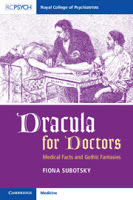 This fascinating new book on the medical context of Bram Stoker's 1897 novel Dracula is by Fiona Subotsky - a retired professor of psychiatry and the widow of Milton Subotsky, producer of the Amicus horror films. I've just submitted a review so shall not detail my thoughts on it here, but here's a note to self for something to look into:
This fascinating new book on the medical context of Bram Stoker's 1897 novel Dracula is by Fiona Subotsky - a retired professor of psychiatry and the widow of Milton Subotsky, producer of the Amicus horror films. I've just submitted a review so shall not detail my thoughts on it here, but here's a note to self for something to look into:"In 1871 [Henry Maudsley] admitted to Lawn House, his small private asylum, a woman called Louisa Lowe whose spiritualistic conversion had led her to 'Passive Writing' in order to communicate with a spirit. Her clergyman spouse was far from keen to have her released, and Maudsley seems to have colluded with this - partly on the grounds that she was threatening to divorce her husband. The latter, however, overplayed his hand and attempted to get hold of his wife's money through a Chancery suit. Maudsley, possibly to avoid the necessary legal review, had Mrs Lowe removed to a different asylum, from which she was very shortly released." (Dracula for Doctors, p. 154)She then attempted to sue the Lunacy Commission and when that failed became active in the Lunacy Law Reform Association, in 1877 getting Maudsley and others involved in her case questioned by a Select Committee. Louisa then helped Mrs Georgina Weldon escape from an asylum and, in 1884, successfully sued the doctor who'd incarcerated her.
This, and accounts of Louisa's shocking treatment in the asylum itself, are apparently detailed in her book The Bastilles of England (1883).
Published on December 10, 2019 07:40
December 3, 2019
Dan Dare on Radio 4 Extra
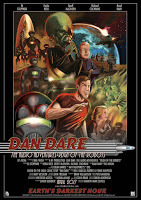 Reign of the Robots, the Dan Dare story by Frank Hampson for Eagle comic that I adapted for audio, will be broadcast on Radio 4 Extra later this month.
Reign of the Robots, the Dan Dare story by Frank Hampson for Eagle comic that I adapted for audio, will be broadcast on Radio 4 Extra later this month.Reign of the Robots part one - 18:25, 21 December 2019Reign of the Robots part two - 18:30, 28 December 2019Dashing test pilot, Dan Dare, Lieutenant Digby and the Eagle Corporation’s Professor Jocelyn Peabody finally return to Earth after battling The Mekon on Venus. Landing in a seemingly deserted central London, they establish that, with the date being 24 June 2045, they have lost ten years.
With limited resources, Dare, Digby and Peabody set about liberating the Earth from an army of ruthless robots. The task becomes more desperate than ever when they discover the alien force behind the invasion...
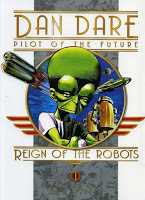 CAST:
CAST:Dan Dare …. Ed Stoppard
Digby …. Geoff McGivern
Professor Peabody …. Heida Reed
The Mekon …. Raad Rawi
George Bryan …. Dean Harris
On-board Computer …. Diane Webber
Sir Hubert .... Michael Cochrane
Eko .... Amy Humphreys
Original music: Imran Ahmad
Dramatised by Simon Guerrier from an original story by Frank Hampson.
Produced and directed by Andrew Mark Sewell.
First released as an audiobook by B7 Productions in 2017.
Published on December 03, 2019 01:46
November 29, 2019
Astounding in the Lancet
 The new issue of medical journal the Lancet Psychiatry includes a review by me:
The new issue of medical journal the Lancet Psychiatry includes a review by me:"Astounding by Alec Nevala-Lee is the story of the hugely influential science fiction magazine of the same name, told through the lives of the magazine's editor John W Campbell and three of his most influential writers: Isaac Asimov, Robert A Heinlein, and L Ron Hubbard. It is also the story of science fiction transcending its humble origins in cheaply produced magazines with relatively few readers to conquer the mainstream. As the prologue tells us, 'For the last two decades, the most successful movie in any given year has nearly always featured elements of science fiction or fantasy…in what amounts to a universal language that can captivate or divert audiences worldwide…The same holds true for literature and television...'" (Simon Guerrier, "The Fiction Behind Science-Fiction", Lancet Psychiatry vol 6, issue 12, pe32, 1 December 2019, DOI:https://doi.org/10.1016/S2215-0366(19...)You need to pay to read the whole thing but here's a short post about the same book from February.
Published on November 29, 2019 02:39
November 16, 2019
Conan Doyle and London
Yesterday, I attended Conan Doyle and London, a one-day symposium organised by the Institute of English Studies and linked to the forthcoming deluxe reissue of Conan Doyle's books by Edinburgh University Press. It was a fascinating, scholarly day - but perfectly pitched to both academics and Sherlockians, as well as the itinerant hack (that was me).
We began with Douglas Kerr's "Man of Letters, Man About Town", which explored Doyle's life in London - the places he lived, the clubs he attended, the male-dominated culture of dinners and connections he was part of.
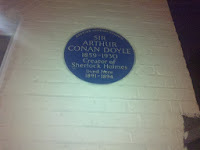 Douglas' first slide was of the blue plaque on the wall of 12 Tennison Road, South Norwood - not far from where I live - and I didn't know that almost as soon as he moved there, Doyle wrote Beyond the City (1891) all about suburban life. As Douglas said, Doyle was writing about experience he'd not quite yet had himself.
Douglas' first slide was of the blue plaque on the wall of 12 Tennison Road, South Norwood - not far from where I live - and I didn't know that almost as soon as he moved there, Doyle wrote Beyond the City (1891) all about suburban life. As Douglas said, Doyle was writing about experience he'd not quite yet had himself.
I should also add that before we started, Douglas made a point of introducing himself to everyone as we arrived, making us all personally welcome. As neither an academic or a Sherlockian, I was feeling a bit of a fraud, a bit daunted by the knowledgeable company I had snuck myself among, so really appreciated that.
Next was Jonathan Cranfield's "Of Time and the City: Conan Doyle and London Print Culture." As a jobbing writer, this was right up my street. How fascinating to understand the kind of literary culture Doyle had grown up in - as a child he sat on Thackeray's knee, as Thackeray was a friend of Doyle's grandfather John. Jonathan also listed Doyle's early publications - one-off commissions in very different styles, each for very different publications. It really hit home: that's how writers begin, trying anything and anyone, slowly developing voice and the all-important relationships with editors and readers. I could well understand Doyle's description of Cornhill editor James Payn, who he met at yet another dinner (this time at the Ship in Greenwich) as a "warden at the gate."
Andrew Lang, editor of Longman's, had dealt with this early, green Doyle and remained a little dismissive of him even after Doyle hit it big.
I was also fascinated by the letters Doyle sent to the press about other writers, muttering at ungentlemanly behaviour of publicising their stories or making too much of the process. He refers in the two letters Jonathan showed us to "wire-pulling," and it only occurred to me afterwards that this might link to Doyle's interest in spiritualism - his strong belief in the truth of it in principle, and his horror at those who faked or exploited it. Was writing just as much of a mystical process to him?
Next came Andrew Glazzard's "'A great traffic was going on, as usual, in Whitehall': Public Places and Private Spaces in Sherlock Holmes' London". This was great, using maps to explore the settings of three spy stories: "The Naval Treaty", "The Second Stain" (a case which Watson tells us in "The Naval Treaty" that he cannot share) and "The Bruce Partingdon Plans". Each one is about the loss of compromising documents, and although foreign agents are keen to buy the missing papers, the fault often lies with incompetent civil servants. Andrew argued that this romanticisation of bureaucracy on which the fate of the nation then hangs would appeal to white-collar commuters reading the Strand.
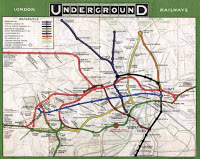 He also linked the bureacractic incompetence of well-connected duffers (something that would never happen in government now, of course) to the "Hotel Cecil" cabinet, stuffed full of relatives of Prime Minister Lord Salisbury, the man from whom we have the phrase "Bob's your uncle." He also linked the stories to other real events in the time they were written or published: the first Official Secrets Act (1889), which was a response to internal carelessness not external threat; the signing of the Entente Cordial in 1904; the coming together of train companies in 1907 which resulted in the first consolidated map of the London Underground network in 1908. Matching story to map shows the all-important journey is from one triangle of lines on the left to a triangle of lines on the right. In these stories, he suggested, we could see a changing relationship to Europe - particularly Germany - in the years preceding the war.
He also linked the bureacractic incompetence of well-connected duffers (something that would never happen in government now, of course) to the "Hotel Cecil" cabinet, stuffed full of relatives of Prime Minister Lord Salisbury, the man from whom we have the phrase "Bob's your uncle." He also linked the stories to other real events in the time they were written or published: the first Official Secrets Act (1889), which was a response to internal carelessness not external threat; the signing of the Entente Cordial in 1904; the coming together of train companies in 1907 which resulted in the first consolidated map of the London Underground network in 1908. Matching story to map shows the all-important journey is from one triangle of lines on the left to a triangle of lines on the right. In these stories, he suggested, we could see a changing relationship to Europe - particularly Germany - in the years preceding the war.
I was really taken by Andrew noting how much the role played in government by Mycroft Holmes changes between his first appearance in "The Greek Interpreter" and his return in "The Bruce Partingdon Plans". It struck me that Mycroft in the latter is an all-powerful special adviser of the sort we're more used to today, a kind of Dominic Cummings but competent. Surely, I thought, there's a story to be told in which Mycroft misses some small element in his great calculations to devastating effect, where things don't quite go as planned despite his reputation for cleverness...
We stopped for lunch, where I chatted to an American academic who specialises in the history of Spanish-speaking countries but is interested in Doyle the spiritualist. Then we were back for
"I have my eyes on a suite in Baker Street" by Catherine Cooke from Westminster Libraries (of which I'm devoted, card-carrying member). Catherine detailed the history of the real Baker Street and the various efforts by Sherlockians to work out where 221B "really" must have been. That then expanded into exploring the bits of London Doyle knew himself, such as the Psychic Bookshop, Library and Museum he part-owned at 2 Victoria Street, telegram address "ECTOPLASM, SOWEST, LONDON". Catherine's paper was so packed with clever deductions and interesting titbits of history - the Marlyebone Road was the first ever bypass, designed to relieve pressure on Oxford Street - that I was too absorbed to scribble many notes.
Then it was "Conan Doyle and Medical London" by Roger Luckhurst - my friend, whose tweet had made my buy a ticket for the event in the first place. Roger's focus was the period 1890-91 when Doyle had consulting rooms on a site almost exactly where we were sitting in Senate House. Just as previous speakers used maps to elucidate Doyle's literary world, Roger used maps to show Doyle's universe as a doctor - where he was, where he aspired to be, what else was around him. The big money was just to the west in Harley Street, working as a specialist, but that was open only to the elite. Doyle, a relatively provincial general practitioner working in Southsea until 1890, then spent a train journey with Sir Malcolm Morris - a well-respected surgeon who'd also started as a lowly GP. As well as his practice, Morris was a writer, a member of the MCC and the Reform Club - and Roger showed the profound influence he had on Doyle's ambitions - the kind of man Doyle wanted to be. That train journey, too, was to see Robert Koch - yet another provincial doctor outside the establishment who'd made it big anyway (in Koch's case by his work on anthrax).
Roger's editing the Edinburgh edition of Doyle's Round the Red Lamp (1894), a collection of medical stories that sound gruesome and disturbing, and were not well-received at the time. Roger linked that response to the horror that met the trial of Oscar Wilde the following year. I dared to ask a question: a lot of the Sherlock Holmes stories are pretty dark and disturbing, and they're also relayed by a doctor - so what made these medical stories different? Roger suggested that Holmes solves or explains the events in his stories and Watson anyway won't share the worst or most disturbing cases. Both, then, frame the events in a reassuring way.
As the son of a consultant, I know doctors share horror stories with one another. There's a sense, I think, of Doyle sharing the kind of tales he swapped in the gentlemanly clubs he belonged to. At least, that's the sense I get without reading the stories - which I now very much mean to.
In the tea-break I spoke to a couple of young academics sat near me: both American, both here pursuing studies that overlapped with Doyle. One asked me how long I'd lived in London. When I said just over 20 years, he said that was how long he'd lived. Reader, I cried into my complimentary biscuit.
Finally, Christine Ferguson's "Cosmopolitan Spiritualism and Doyle's The Land of Mist" explored the 1926 novel seen as propaganda for Doyle's belief in the spirit world - in which even the great cynic Professor Challenger goes from calling it all "twaddle" to becoming a true believer. Christine described Challenger as a kind of blend of Brian Blessed and TH Huxley, with a quote from Huxley where he also described spiritualism as twaddle.
The general consensus in the room from those who've read and know the book is that The Land of Mist isn't very good. Christine thought Arnold Bennett's The Glimpse (1909) a better advertisement for the world of the spirits, one in vivid colour whereas Doyle's is all grey. That made me think of A Matter of Life and Death, where the after-life is in monochrome and to be appealed against. Christine also said she found Doyle's evidence, his arguments, unconvincing - and afterwards it struck me that if he'd really wanted to convince his readers of the truth of his beliefs, he'd have done better using another of his characters. Imagine Sherlock Holmes as a convert, the zeal with which he'd pronounce the evident, empirical truth...
To conclude, Douglas Kerr told us more about the forthcoming reissue of Doyle's books, beginning with the autobiography Memories and Adventures, which should be out sometime next year. There was natter and wine after, and then I reached St Pancras just as a fast, direct train back to Norwood Junction pulled in - Doyle's ghost evidently looking over me. Home in good time to say goodnight to the children, me and the Dr then caught up on the final episode of Dublin Murders, a properly disturbing case filled with the ghosts of the past.
Related wittering:
"Silver Blaze," my review for the Lancet Psychiatry of 2015 film Mr Holmes"My immortal Holmes," my review for the Lancet Psychiatry of a 2015 Sherlock Holmes exhibitionMe on 2011 Holmes novel The House of SilkMe on 2005 novel Arthur and George, about Conan DoyleMe on Doyle and canon
We began with Douglas Kerr's "Man of Letters, Man About Town", which explored Doyle's life in London - the places he lived, the clubs he attended, the male-dominated culture of dinners and connections he was part of.
"Few men are ever absolutely natural when there are women in the room." Conan Doyle, Memories and Adventures: An Autobiography, p. 265.That clubbable culture was essential to his career: on 30 August 1889, at a dinner at the Langham Hotel, Doyle was commissioned by editor Joseph M Stoddart to write the second Sherlock Holmes adventure, The Sign of Four, to be published in Lippincott's Monthly Magazine. Oscar Wilde was at the same dinner, and soon afterward wrote The Picture of Dorian Gray for the same editor and publication (the implication being, I think, that he was commissioned at the same dinner).
 Douglas' first slide was of the blue plaque on the wall of 12 Tennison Road, South Norwood - not far from where I live - and I didn't know that almost as soon as he moved there, Doyle wrote Beyond the City (1891) all about suburban life. As Douglas said, Doyle was writing about experience he'd not quite yet had himself.
Douglas' first slide was of the blue plaque on the wall of 12 Tennison Road, South Norwood - not far from where I live - and I didn't know that almost as soon as he moved there, Doyle wrote Beyond the City (1891) all about suburban life. As Douglas said, Doyle was writing about experience he'd not quite yet had himself.I should also add that before we started, Douglas made a point of introducing himself to everyone as we arrived, making us all personally welcome. As neither an academic or a Sherlockian, I was feeling a bit of a fraud, a bit daunted by the knowledgeable company I had snuck myself among, so really appreciated that.
Next was Jonathan Cranfield's "Of Time and the City: Conan Doyle and London Print Culture." As a jobbing writer, this was right up my street. How fascinating to understand the kind of literary culture Doyle had grown up in - as a child he sat on Thackeray's knee, as Thackeray was a friend of Doyle's grandfather John. Jonathan also listed Doyle's early publications - one-off commissions in very different styles, each for very different publications. It really hit home: that's how writers begin, trying anything and anyone, slowly developing voice and the all-important relationships with editors and readers. I could well understand Doyle's description of Cornhill editor James Payn, who he met at yet another dinner (this time at the Ship in Greenwich) as a "warden at the gate."
Andrew Lang, editor of Longman's, had dealt with this early, green Doyle and remained a little dismissive of him even after Doyle hit it big.
"Now the native pewter of Sherlock Holmes is a sixpenny magazine with plenty of clever illustrations." Andrew Lang, "The Novels of Conan Doyle", Quarterly Review (July 1904), p. 160.But Jonathan seemed to argue that Lang had a point. The Strand was the first magazine to have an art editor (WHJ Boot), with a picture on every "opening" - I think that means spread. That wasn't just Sidney Paget's extraordinary, vivid illustrations: the Holmes stories include maps, ciphers and fragments of documents. (In The Mysterious Affair at Styles , Agatha Christie mentions Holmes just a paragraph before the first mention of her own detective, Hercule Poirot, indicating the legacy of Doyle; her book also has maps and fragments.)
I was also fascinated by the letters Doyle sent to the press about other writers, muttering at ungentlemanly behaviour of publicising their stories or making too much of the process. He refers in the two letters Jonathan showed us to "wire-pulling," and it only occurred to me afterwards that this might link to Doyle's interest in spiritualism - his strong belief in the truth of it in principle, and his horror at those who faked or exploited it. Was writing just as much of a mystical process to him?
Next came Andrew Glazzard's "'A great traffic was going on, as usual, in Whitehall': Public Places and Private Spaces in Sherlock Holmes' London". This was great, using maps to explore the settings of three spy stories: "The Naval Treaty", "The Second Stain" (a case which Watson tells us in "The Naval Treaty" that he cannot share) and "The Bruce Partingdon Plans". Each one is about the loss of compromising documents, and although foreign agents are keen to buy the missing papers, the fault often lies with incompetent civil servants. Andrew argued that this romanticisation of bureaucracy on which the fate of the nation then hangs would appeal to white-collar commuters reading the Strand.
 He also linked the bureacractic incompetence of well-connected duffers (something that would never happen in government now, of course) to the "Hotel Cecil" cabinet, stuffed full of relatives of Prime Minister Lord Salisbury, the man from whom we have the phrase "Bob's your uncle." He also linked the stories to other real events in the time they were written or published: the first Official Secrets Act (1889), which was a response to internal carelessness not external threat; the signing of the Entente Cordial in 1904; the coming together of train companies in 1907 which resulted in the first consolidated map of the London Underground network in 1908. Matching story to map shows the all-important journey is from one triangle of lines on the left to a triangle of lines on the right. In these stories, he suggested, we could see a changing relationship to Europe - particularly Germany - in the years preceding the war.
He also linked the bureacractic incompetence of well-connected duffers (something that would never happen in government now, of course) to the "Hotel Cecil" cabinet, stuffed full of relatives of Prime Minister Lord Salisbury, the man from whom we have the phrase "Bob's your uncle." He also linked the stories to other real events in the time they were written or published: the first Official Secrets Act (1889), which was a response to internal carelessness not external threat; the signing of the Entente Cordial in 1904; the coming together of train companies in 1907 which resulted in the first consolidated map of the London Underground network in 1908. Matching story to map shows the all-important journey is from one triangle of lines on the left to a triangle of lines on the right. In these stories, he suggested, we could see a changing relationship to Europe - particularly Germany - in the years preceding the war.I was really taken by Andrew noting how much the role played in government by Mycroft Holmes changes between his first appearance in "The Greek Interpreter" and his return in "The Bruce Partingdon Plans". It struck me that Mycroft in the latter is an all-powerful special adviser of the sort we're more used to today, a kind of Dominic Cummings but competent. Surely, I thought, there's a story to be told in which Mycroft misses some small element in his great calculations to devastating effect, where things don't quite go as planned despite his reputation for cleverness...
We stopped for lunch, where I chatted to an American academic who specialises in the history of Spanish-speaking countries but is interested in Doyle the spiritualist. Then we were back for
"I have my eyes on a suite in Baker Street" by Catherine Cooke from Westminster Libraries (of which I'm devoted, card-carrying member). Catherine detailed the history of the real Baker Street and the various efforts by Sherlockians to work out where 221B "really" must have been. That then expanded into exploring the bits of London Doyle knew himself, such as the Psychic Bookshop, Library and Museum he part-owned at 2 Victoria Street, telegram address "ECTOPLASM, SOWEST, LONDON". Catherine's paper was so packed with clever deductions and interesting titbits of history - the Marlyebone Road was the first ever bypass, designed to relieve pressure on Oxford Street - that I was too absorbed to scribble many notes.
Then it was "Conan Doyle and Medical London" by Roger Luckhurst - my friend, whose tweet had made my buy a ticket for the event in the first place. Roger's focus was the period 1890-91 when Doyle had consulting rooms on a site almost exactly where we were sitting in Senate House. Just as previous speakers used maps to elucidate Doyle's literary world, Roger used maps to show Doyle's universe as a doctor - where he was, where he aspired to be, what else was around him. The big money was just to the west in Harley Street, working as a specialist, but that was open only to the elite. Doyle, a relatively provincial general practitioner working in Southsea until 1890, then spent a train journey with Sir Malcolm Morris - a well-respected surgeon who'd also started as a lowly GP. As well as his practice, Morris was a writer, a member of the MCC and the Reform Club - and Roger showed the profound influence he had on Doyle's ambitions - the kind of man Doyle wanted to be. That train journey, too, was to see Robert Koch - yet another provincial doctor outside the establishment who'd made it big anyway (in Koch's case by his work on anthrax).
Roger's editing the Edinburgh edition of Doyle's Round the Red Lamp (1894), a collection of medical stories that sound gruesome and disturbing, and were not well-received at the time. Roger linked that response to the horror that met the trial of Oscar Wilde the following year. I dared to ask a question: a lot of the Sherlock Holmes stories are pretty dark and disturbing, and they're also relayed by a doctor - so what made these medical stories different? Roger suggested that Holmes solves or explains the events in his stories and Watson anyway won't share the worst or most disturbing cases. Both, then, frame the events in a reassuring way.
As the son of a consultant, I know doctors share horror stories with one another. There's a sense, I think, of Doyle sharing the kind of tales he swapped in the gentlemanly clubs he belonged to. At least, that's the sense I get without reading the stories - which I now very much mean to.
In the tea-break I spoke to a couple of young academics sat near me: both American, both here pursuing studies that overlapped with Doyle. One asked me how long I'd lived in London. When I said just over 20 years, he said that was how long he'd lived. Reader, I cried into my complimentary biscuit.
Finally, Christine Ferguson's "Cosmopolitan Spiritualism and Doyle's The Land of Mist" explored the 1926 novel seen as propaganda for Doyle's belief in the spirit world - in which even the great cynic Professor Challenger goes from calling it all "twaddle" to becoming a true believer. Christine described Challenger as a kind of blend of Brian Blessed and TH Huxley, with a quote from Huxley where he also described spiritualism as twaddle.
The general consensus in the room from those who've read and know the book is that The Land of Mist isn't very good. Christine thought Arnold Bennett's The Glimpse (1909) a better advertisement for the world of the spirits, one in vivid colour whereas Doyle's is all grey. That made me think of A Matter of Life and Death, where the after-life is in monochrome and to be appealed against. Christine also said she found Doyle's evidence, his arguments, unconvincing - and afterwards it struck me that if he'd really wanted to convince his readers of the truth of his beliefs, he'd have done better using another of his characters. Imagine Sherlock Holmes as a convert, the zeal with which he'd pronounce the evident, empirical truth...
To conclude, Douglas Kerr told us more about the forthcoming reissue of Doyle's books, beginning with the autobiography Memories and Adventures, which should be out sometime next year. There was natter and wine after, and then I reached St Pancras just as a fast, direct train back to Norwood Junction pulled in - Doyle's ghost evidently looking over me. Home in good time to say goodnight to the children, me and the Dr then caught up on the final episode of Dublin Murders, a properly disturbing case filled with the ghosts of the past.
Related wittering:
"Silver Blaze," my review for the Lancet Psychiatry of 2015 film Mr Holmes"My immortal Holmes," my review for the Lancet Psychiatry of a 2015 Sherlock Holmes exhibitionMe on 2011 Holmes novel The House of SilkMe on 2005 novel Arthur and George, about Conan DoyleMe on Doyle and canon
Published on November 16, 2019 04:27
November 15, 2019
One Good Turn, by Kate Atkinson
 After
Case Histories
comes One Good Turn, which brings former soldier, cop and private detective Jackson Brodie out of retirement, ruining the happy ending of that previous, devastatingly sad book.
After
Case Histories
comes One Good Turn, which brings former soldier, cop and private detective Jackson Brodie out of retirement, ruining the happy ending of that previous, devastatingly sad book.Jackson's at the Edinburgh Festival where his actress girlfriend is in a terrible play. Idling around without her during the day, Jackson is by chance witness to a moment's road rage but doesn't want to get involved. He then, by chance, discovers a dead body - but loses it again. Then a man tries to kill him, and when Jackson fights back he ends up on a charge. This does not help convince newly promoted Detective Sergeant Louise Monroe that he is a good guy. Which is tricky because Lousie and Jackson clearly fancy one another...
In fact, Jackson doesn't turn up until page 51 and the road rage incident is first conveyed from the perspective of two other people, including Martin Canning - an author of not very good detective stories, which allows Atkinson some fun. For example, there's the flashback to Martin taking a first writing class and the teacher's words that inspired him to make it his job:
"You're the only one in the class who can put one word in front of another and not make want to fucking puke, excuse my split infinitive. You should be a writer." (p. 38)There's the strange competition and jockeying for position that goes on at panels of writers. Or there's the simple truth of what writing involves:
"For some reason people thought it was a glamorous profession but Martin couldn't find anything glamorous about sitting in a room on your own, day after day, trying not to go mad." (p. 122)There's a lot of this - the meandering thoughts of the characters in whose heads we're in, their memories and connections and musings. Concealed in some of this are vital clues to the plot, but it largely feels like Atkinson is just having fun. The result is that the story, for all it is about murder and corruption, and the disintegration of relationships, is much less cold and disturbing than Case Histories.
Yet there are moments when she twists the knife, as when a character I won't name here is encumbered by a dead body.
"The only thing he could see was her handbag. He rifled through it to make sure there was nothing to incriminate him, that she hadn't written down his name and hotel address. Nothing, just a cheap purse, some keys, a tissue and lipstick. A photograph in a plastic wallet. The photograph was of a baby, its sex indeterminate. [Name] refused to think about the significance of a photograph of a baby." (p. 494)That's horrific, as is what then happens to the body.
"He had thrown a human being away like rubbish." (p. 496)That haunts the reader as it does the man I won't name.
Atkinson is brilliant at these distinct characters, and the book is full of telling detail. Another principal figure is Gloria Hatter, frustrated wife of a dodgy businessman. Gloria poses as a potential buyer to nose rounds the houses that her husband's company builds, and gives a perfectly withering assessment of the company - and him.
"Everything was built to the tightest specifications, as little garden as possible, the smallest bathroom - it was as if a very mean person had decided to build houses." (p. 254)As before, the disparate elements are eventually woven together in a satisfying way. My only disquiet is what happens in Jackson's love life - he's told something towards the end of the novel about a third party, but not who that is or what exactly happened, a mystery that lingers. But I loved the final pages in which we return to a character from the beginning and learn something new and devastating and brilliant about someone we thought we knew.
I'm very much looking forward to the next Jackson Brodie novel, When Will There Be Good News?
PS
I've added this sighting to my list of Doctor Who references in non-Doctor Who books:
"He had another cup of coffee as he walked, dispensed from a kiosk that used to be a blue police box, a Tardis. It was a strange world, Jackson thought. Yes, sirree." (p. 274)
Published on November 15, 2019 01:00
Simon Guerrier's Blog
- Simon Guerrier's profile
- 60 followers
Simon Guerrier isn't a Goodreads Author
(yet),
but they
do have a blog,
so here are some recent posts imported from
their feed.



